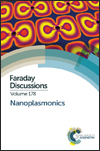Electrical control of Faraday rotation at a liquid–liquid interface†
Abstract
A theory is developed for the Faraday rotation of light from a monolayer of charged magnetic nanoparticles at an electrified liquid–liquid interface. The polarization fields of neighboring nanoparticles enhance the Faraday rotation. At such interfaces, and for realistic sizes and charges of nanoparticles, their adsorption–desorption can be controlled with a voltage variation <1 V, providing electrovariable Faraday rotation. A calculation based on the Maxwell-Garnett theory predicts that the corresponding redistribution of 40 nm nanoparticles of yttrium iron garnet can switch a cavity with a quality factor larger than 104 for light of wavelength 500 nm at normal incidence.
- This article is part of the themed collection: Nanoplasmonics

 Please wait while we load your content...
Please wait while we load your content...